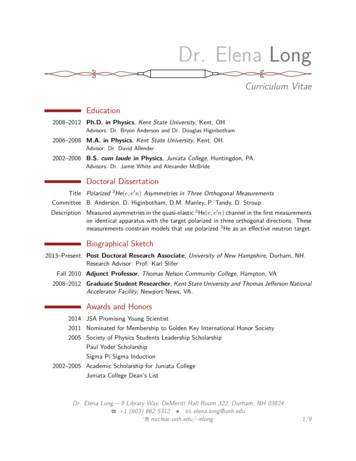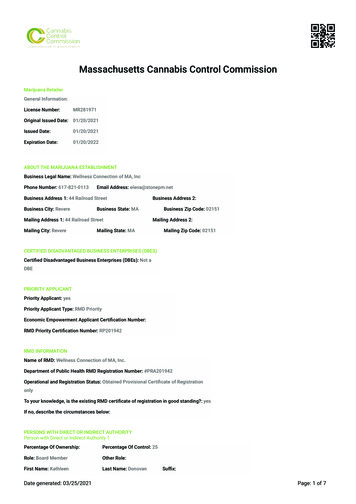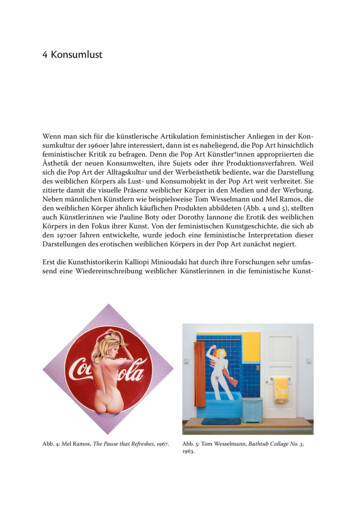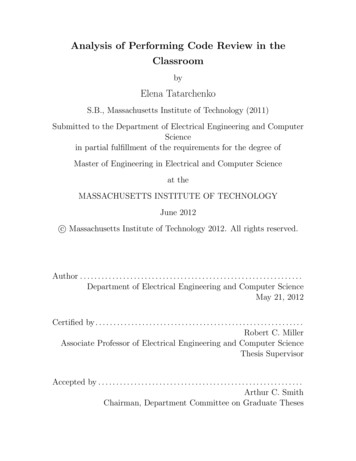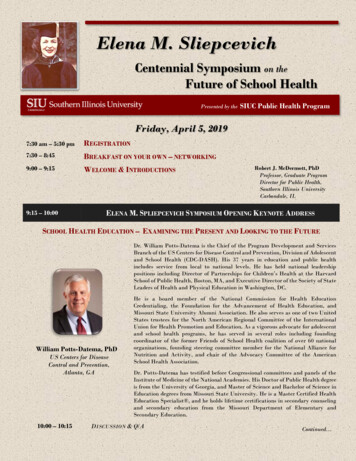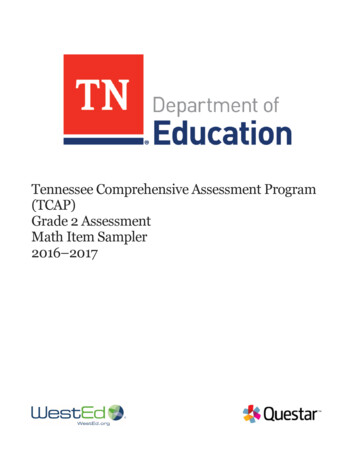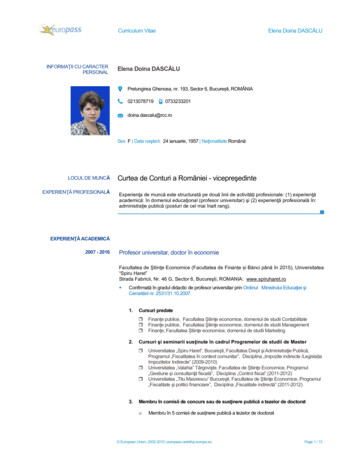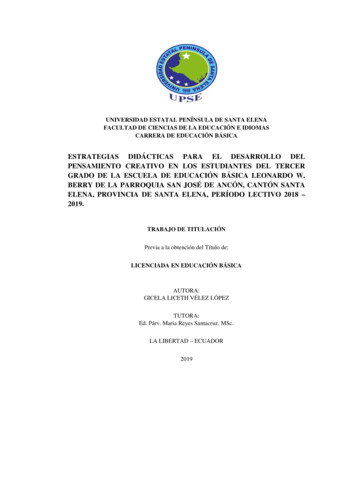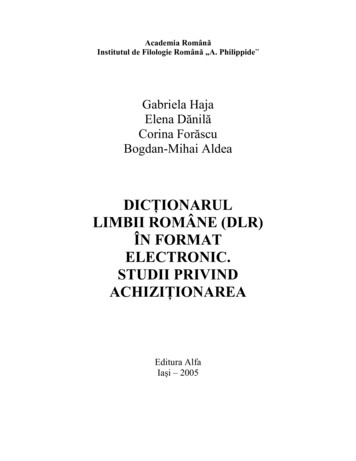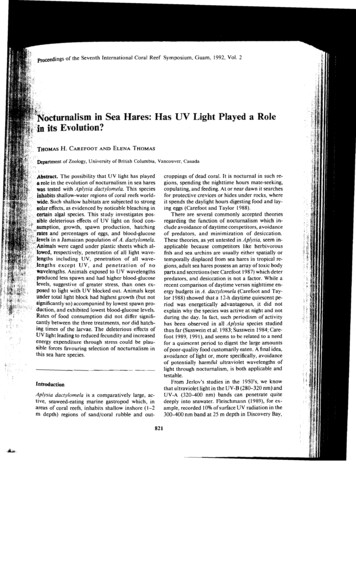
Transcription
THOMASH. CAREFOOTAND ELENA THOMASDepartment of Zoology, University of Bnt shColumbia, Vancouver, Canada-,-Abstract. The possibility that UV light has playeda role in the evolution of nocturnalism in sea hareswas tested with Aplysia dactylomela. Thls speclesinhabits shallow-water reglons of coral reefs worldwide. Such shallow habitats are subjected to strongsolar effects, as evidenced by noticable bleaching Incertain algal species. This study investigates pos6ible deleterious effects of UV light on food consumption, growth, spawn production, hatchingfEltes and percentages of eggs, and blood-glucosecroppings of dead coral. It is nocturnal in such regions, spending the nighttime hours mate-seeklng,copulating, and feeding. At or near dawn it searchesfor protective crevices or hides under rocks, whereit spends the daylight hours digesting food and laying eggs (Carefoot and Taylor 1988).There are several commonly accepted theonesregarding the function of nocturnalism which include avo danceof daytime competitors, avoidanceof predators, and m i n m i z a t oofn desiccation.posed to light with UV blocked out. Animals keptunder total light block had highest growth (but notsignificantly so) accompanied by lowest spawn production, and exhibited lowest blood-glucose levels.Rates of food consumption d dnot differ significantly between the three treatments, nor did hatching times of the larvae. The deleterious effects ofUVlight leading to reduced fecundity and Increasedexpenditure through stress could be plausible forces favouring selection of nocturnalism inthis sea hare species.ergy budgets In A. dactylomela (Carefoot and Taylor 1988) showed that a 12-h daytime quiescent period was energetically advantageous, lt dld notexplain why the species was active at night and notduring the day. In fact, such periodism of activityhas been observed in all Aplysia species studiedthus far (Susswein et a]. 1983; Susswein 1984; Carefoot 1989, I 99 I), and seems to be related to a needfor a quiescent penod to digest the large amountsof poor-quality food customarily eaten. A final idea,avo danceof light or, more specifically, avoidanceof potentially harmful ultraviolet wavelengths oflight through nocturnalism, is both applicable andtestable.From Jerlov's studies in the 1950's, we knowthat ultraviolet light in the UV-B (280-320 nm) andUV-A (320-400 nm) bands can penetrate qultedeeply Into seawater. Fleischmann (1989), for example, recorded 10% of surface UV radiation in the300-400 nm band at 25 m depth in Discovery Bay,IntroductionAplysla dactylomela is a comparatively large, actlve, seaweed-eating marine gastropod which, inareas of coral reefs, inhab tsshallow inshore (1-2m depth) regions of sand/coral rubble and out-82 1
Carefoot and ThomasJamaica. In the 1-2 m depth-range inhabited byAplysia dactylomela in Discovery Bay, over 60% ofthis band of UV light was present. Strong penetration of UV-B radiation into clear oceanic water hasbeen shown by Jerlov (1950) in the Sargasso Sea(attenuation of only 14%.m-I) and by Smith andBaker (1 979) in the Gulf of Mexico(l5-20%.m-'),and even in coastal waters can be substantial (Lenoble 1956; Wood 1987, 1989).Effects of solar UV radiation on the marine ecosystem are becoming increasingly well known, andinclude inhibition of phytoplankton productivityand motility (Lorenzen 1979; Biihlmann et al. 1987;lengths including UV (designated UVTRANSP), 2)e x p o s u r e t o a l l w a v e l e n g t h s e x c e p t uv(UVBLOCK), or 3) exposure to no direct light atall (TOTALBLOCK).The caging arrangements were as follows. The12 individuals in each group were randomly subdivided into six pairs, and each pair assigned to amesh basket (25 X 15 X 12 cm height, 0.6 cmplastic mesh). The six baskets per treatment weresuspended from the undersurface of PLEXIGLAS@acrylic plastic sheets (0.6 cm thick, 100 X 40 cm)of compositions which allowed different light wavelengths to be transmitted. Hinged panels of thesea anemones (Lesser and Shick 1989).The question was raised as to whether UV lightmight be affectingAplysia dactylomela when we observed that the seaweed Acan thophora spicifera hadThe light transmission characteristics forscreening material were, for UVTRANSP: allvisible radiation above 275 nm transmittedinhabited by this animal. With the view, then, thatnocturnalism in sea hares may have evolved in re-UVBLOCK:UV Or shOrt-wavelength450 n m transmitted and, foreterious effects of natural levels of UV light in A.dactylornela. We predicted that exposure to UVlight would be stressful to the sea hares, resultingin higher blood-glucose levels, lower food consumption, and lessened body growth, spawn production, and spawn vitality.Ltd.). Light (400-700 nm) penetration toJunel 5 Cm depth was measured at I2O0On1991 in full sun as 88% under UVTRANSP, 87%under UVBLOCK and 27%bottomand scatter) underBody weight was recorded for each animal atDay 0, and thereafter at 5-d intervals, over the 25d duration of the experiment. Spawn weights weremeasured daily and selected pieces cultured individually to determine hatching times and hatchingpercentages (expressed as percentage of capsulesthat opened and released larvae). T o correct for different body weights in each treatment, and becausespawn from a given animal in a basket could notMaterials and MethodsSea hares of 150-400 g live wt were collected fromshallow coral-rock areas near the Discovery BayMarine Laboratory, Jamaica, in May 1991. Theywere sorted according to size and divided into threegroups of 12 individuals, each group of 230 g mean
Nocturnalism in Sea Hares-Fig. 1- Change in weight of A P Y Sdacrylomela; subjectedto differences in type and amount of light. Each point r e presents the mean o f 12 animals. UVTRANSP: exposure toall light wavelengths including UV; UVBLOCK: exposureto all wavelengths except UV; TOTALBLOCK: no exposure to direct light.Fig. 2. Cumulative food consumption by Aplysia dactylomela in the UV-experiment. Data points represent mean ofN 6. Treatment designation same as in Fig. I .pressed as equivalent dry weight eaten per live kganimal (after drying of selected pieces at 70" C toconstant weight). Blood samples were drawn fromselected animals (N 6) in each treatment at Day0, and at 8-d ifitervals thereafter, and analysed forglucose concentration (following the method inCarefoot 1991). Sampling was done at 1000 h oneach designated day, a time when animals weremetabolically quiescent (Carefoot 1991). Wheretimeeffects were involved, data were analysed byRepeated Measures ANOVA''by Tukey'sCom arisonsTests (TMCT). Other data,such as between-treatments comparisons of hatching times and percentages (after arcsine transformation), were analysed by ordinary ANOVA andFig. 1 shows weight changes in field animals over25 d. TOTALBLOCK animals grew more thanthose in the other treatments, but differences werenot significant (F, ,,,, 0.50, p 0.61, ANOVA).Time-effects were highly significant ( F , , , 3 1.85,p 0.001), with the data segregating into two statistically homogenous subsets: Days 0-5 and theremainder ( p 0.05, TMCT). The flat portions ofthe growth curves are likely explained by all extrabut weenergy being converted intohave no explanation for the Days 5-1 0 rise, as therewas no obvious change in amounts of spawn beingproduced during this time (see later).No significant difference was found in amountof food consumed among treatments (Fig. 2; F,,,segregating into three homogenous subsets, the firstrepresenting Days 0-5 (62 dry g alga eaten-live kgbody wt-I 5d-1); the second, Days 5-10 (83); andthe third, Days 10-25 (107-109; p 0.05, TMCT).These differences likely resulted from an initial several day delay before we were able to give the animals enough food to match their appetites. Oncead libitum feeding conditions were reached, foodconsumption rates became more even. Higher ratesof food consumption should have been reflected inhigher growth and/or spawn production but thiswas not evident (see Figs. 1 and 3). During the lastfive days of the experiment, each pair of sea hareswas eating an amount of fresh food equivalent to22% of their live body wt per day.-510152025Fig. 3. Cumulative spawnby Aplysja dactylomela in the Uv-experiment. Data points represent mean o fN 6. Treatments same as in Fig. I .Food, consisting mainly of the red alga Acanthophora spicifera, but including some Centroceras ciavuiatum, was provided daily. Uneaten remnantswere collected daily and their weights subtracted
w. -Carefoot and ThomasCumulative spawn production over the 25-d experimental penod is shown in Fig. 3. Treatmenteffects were highly significant (F,,, 7.60, p 0.005), with most spawn being laid by UVBLOCKand least by TOTALBLOCK animals (means of 5 1and 33 live g spawn live kg animal-I 5-d-I, respectively. TMCT disclosed two statistically homogenous subsets representing UVBLOCK andUVTRANSP/TOTALBLOCK). No time effectswere evident.Hatching times of spawn (8.5-9.6 d at 2526" C), shown in Table 1, were not significantlydifferent among the three treatments (F,,,, 2.13,p 0.14). Interestingly, TOTALBLOCK animalsexhibited smaller percentage hatching (66%) thaneither UVBLOCK or UVTRANSP ones (81 and95%, respectively), but the differences were not significant (F, ,, 2.14, p 0.13).Changes in blood-glucose levels are shown inFig. 4. There were highly significant treatment effects (F,, 12.20, p 0.001), with the data segregating into three non-overlapping subgroups (p 0.05, TMCT). Overall means ( S.D. in pg glucoseml hernolymph-I) were: UVTRANSP 30.1 7.8, UVBLOCK 25.8 6.8, and TOTALBLOCK 2 1.5 9.1. The UVTRANSp valuecompares favourably with a value of 30.8 pg glucoseml-I recorded previously in a field population ofAplysla dactylomela in Discovery Bay at 0900h(Carefoot 1991). There was a significant time-effect(F,, 6.53, p 0.001), with levels being loweron Days 16-24 than on Days 0-8 (21.4-22.8, and29.5-29.6 pg. m l - respectively;, 0.05, TMCT).---Our predictions regarding the effect of solar UVradiation on A P Ywere L supported to the extentthat blood-glucose levels were higher, suggestive ofgreater stress, and spawn production lower, in animals exposed to direct sunlight with UV. However,rates of food consumption did not differ between thethree treatment groups, nor did rates of body growthdiffer significantly between anlmals exposed to solarradiation with and without UV. There are two possibillties to consider with respect to the role of UVlight on Aplysia behavior: the first, as already noted,is that UV light plays a proximate role in directlystressing the animals and, the second, is that theanimals simply use UV light as a cue to tell themthat it is time to find a daytime shelter in which torest and digest their food. In this case, the elevatedblood glucose would simply be a consequence ofgreater activity as the animals seek shelter.Adult Aplysra with access to copulatory partnersallocate most of their growth energy to productionof spawn. Conversely, in the absence of egg production or spawning stimuli, energy is predominately allocated to somatic growth. Thus, it was notunexpected that the treatment group showing mostsomatic growth (TOTALBLOCK; see Fig. 1, butnote that the difference was not significant) wouldbe the one laying least spawn, but the causes forthis were unclear. Does absence of direct light inhibit conversion of food energy into spawn in seahares? Aplysla dactylomela and A. uliana,bothnocturnal, are known to lay most eggs during daytime (Sarver 1978; Carefoot and Taylor 1988). Thismight suggest that either light, even if shaded, stimulates laying, or it might simply be that while resting during daytime the sea hares engage in egg-laying as well as some copulatory behaviour whichdoes not require them to leave their protective hideaways.The treatment groups exposed to direct light(UVBLOCK and UVTRANSP) showed an almostidentical Pattern of growth (Fig. 1). Spawn r o d u c tion by UVTRANSP anlmals was significantly lessthan that by UVBLOCK animals (Fig. 3), suggesting an inhibitory effect of UV light. Since food con m p t i owasn almost identical in these two treatm e n t s, t h e extra energy accruing t o theUVTRANSP group (represented by the differencein Spawn production) was presumably allocated tol o c m o t o r yactivity or other stress-related responses related to exposure to UV light. he basisfor this belief is the significantly higher level ofblood-glucose in the UVTRANSP group as compared with the others (Flg. 4).Elevated blood-glucose levels in Aplysia arise inat least three ways: during locomotory or otherphysical activity, from presence of food in the gut,or through stress associated with air exposure, elevated temperature, low salinity, perforation of thegut, and electrical shock (Ram and Young 1992;Carefoot 1993). Since all treatment groups ate moreor less equally (Fig. 2), differences in amount offood in the gut can be dismissed as a probable causeof higher blood-glucose level in one group over another. This leaves locomotory activity or stress asmost likely causes. These factors are not unrelated.Aplysla, like any other animal when stressed, willincrease energy expenditure through activation ofsensory systems and acceleration of enzyme turnover and blood circulation, to enter a state of metabolic preparedness for "flight or fight". Unfortunately, the physical arrangement of the cages didnot permit easy observation of locomotory behaviour, either not allowing clear view because of wave
Carefoot and ThomasHader D-P (1 986) Effects of solar and artificial UV irradiationon motility and phototaxis in the flagellate, Euglena gracilis. Photochem Photobiol 44:651-656Hader D-P, Hader MA (1988) Ultraviolet-B inhibition of motility in green and dark bleached Euglena gracilis. CurrMicrobial 17:2 15-220Hader D-P, Hader M (1 991) Effects of solar and artificial U.V.radiation on motility and pigmentation in the marineCryptomonas maculata. Envir Exp Bot 3 1:33-41Hader D-P, Worrest RC (1991) Effects of enhanced solar ultraviolet radiation on aquatic ecosystems. PhotochemPhotobiol 53:7 17-725Hobson LA, Hartley FA (1 983) Ultraviolet irradiance andprimary production in a Vancouver Island fiord, BritishColumbia, Canada. J Plankton Res 5:325-331Jerlov NG (1950) Ultra-violet radiation in the sea. Nature166:Ill-112Jokiel PL (1980) Solar ultraviolet radiation and coral reefepifauna. Science 207: 1069- 107 1Jokiel PL, York Jr. RH (1982) Solar ultraviolet photobiologyof the reef coral Pocillopora damicornis and symbioticzooxanthellae. Bull Mar Sci 32:301-3 15Lenoble J (1956) Sur la Enitration du rayonnement ultraviolet dans les eaux mkditerrantennes. C R Acad Sci243:1781-1783Lesser MP, Shick J M (1989) Effects of irradiance and ultraviolet radiation on photoadaptation in the zooxanthellaeof Aiptasia pallida: primary production, photoinhibition,and enzymic defenses against oxygen toxicity. Mar Biol102:243-255Lorenzen CJ (1979) Ultraviolet radiation and phytoplanktonphotosynthesis. Limn01 Oceanogr 24: 11 17-1 120Liining K (198 1) Egg release in gametophytes of Laminariasaccharina: induction by darkness and inhibition by bluelight and U.V. Br Phycol J 16:379-393McArdle J, Bullock AM (1987) Solar ultraviolet radiation asa causal factor of 'summer syndrome' in cage-reared Atlantic salmon, Salmo salar L.: a clinical and histopathological study. J Fish Dis 10:255-264Ram JL, Young ES (1992) Shock induces a long-lasting elevation of blood glucose in Aplysia. Experientia 48: 14- 1 8Sarver DJ (1978) The ecology and energetics of Aplysia juliana (Quoy and Qaimard, 1832). Ph.D. thesis, Universityof Hawaii. pp 125Shibata K (1 969) Pigments and a UV-absorbing substance incorals and a blue-green alga living in the Great BarrierReef. Plant Cell Physiol 10:325-335Smith RC, Baker KS (1979) Penetration of UV-B and biologically effective dose-rates in natural waters. PhotochemPhotobiol 29:311-323Susswein AJ (1 984) Effects of food deprivation upon behavioral patterns and time budgeting of Aplysia fasciata. Behav Neural Biol 42: 127- 133Susswein AJ, Gev S, Feldman E, Markovich S (1 983) Activitypatterns and time budgeting ofAplysiafasciata under fieldand laboratory conditions. Behav Neural Biol 39:203-220Willan RC (1979) The ecology of two New Zealand opisthobranch molluscs. Ph.D. thesis, University of Aukland.PP 198Wood W F (1 987) Effect of solar ultra-violet radiation on thekelp Ecklonia radiata. Mar Biol 96: 143- 1 50Wood W F (1989) Photoadaptive responses of the tropical redalga Eucheuma striatum Schmitz (gigartinales) to ultraviolet radiation. Aquat Bot 33:41-51
THOMAS H. CAREFOOT AND ELENA THOMAS Department of Zoology, University of Bnt sh Columbia, Vancouver, Canada Abstract. The possibility that UV light has played croppings of dead coral. It is nocturnal in such re- a role in the evolution of nocturnalism in sea hares gions, spending the nighttime hours mate-seeklng, - was tested with Aplysia .

